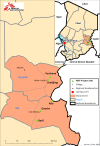Implementation and utilisation of community-based mortality surveillance: a case study from Chad
- PMID: 23186330
- PMCID: PMC3560199
- DOI: 10.1186/1752-1505-6-11
Implementation and utilisation of community-based mortality surveillance: a case study from Chad
Abstract
Background: Prospective surveillance is a recognised approach for measuring death rates in humanitarian emergencies. However, there is limited evidence on how such surveillance should optimally be implemented and on how data are actually used by agencies. This case study investigates the implementation and utilisation of mortality surveillance data by Médecins Sans Frontières (MSF) in eastern Chad. We aimed to describe and analyse the community-based mortality surveillance system, trends in mortality data and the utilisation of these data to guide MSF's operational response.
Methods: The case study included 5 MSF sites including 2 refugee camps and 3 camps for internally displaced persons (IDPs). Data were obtained through key informant interviews and systematic review of MSF operational reports from 2004-2008.
Results: Mortality data were collected using community health workers (CHWs). Mortality generally decreased progressively. In Farchana and Breidjing refugee camps, crude death rates (CDR) decreased from 0.9 deaths per 10,000 person-days in 2004 to 0.2 in 2008 and from 0.7 to 0.1, respectively. In Gassire, Ade and Kerfi IDP camps, CDR decreased from 0.4 to 0.04, 0.3 to 0.04 and 1.0 to 0.3. Death rates among children under 5 years (U5DR) followed similar trends. CDR and U5DR crossed emergency thresholds in one site, Kerfi, where CDR rapidly rose to 2.1 and U5DR to 7.9 in July 2008 before rapidly decreasing to below emergency levels by September 2008.
Discussion: Mortality data were used regularly to monitor population health status and on two occasions as a tool for advocacy. Lessons learned included the need for improved population estimates and standardized reporting procedures for improved data quality and dissemination; the importance of a simple and flexible model for data collection; and greater investment in supervising CHWs.
Conclusions: This model of community based mortality surveillance can be adapted and used by humanitarian agencies working in complex settings. Humanitarian organisations should however endeavour to disseminate routinely collected mortality data and improve utilisation of data for operational planning and evaluation. Accurate population estimation continues to be a challenge, limiting the accuracy of mortality estimates.
Figures







References
-
- Galway L, Bell N, Al Shatari S, Hagopian A, Burnham G, Flaxman A, Weiss W, Rajaratnam J, Takaro T. A two-stage cluster sampling method using gridded population data, a GIS, and Google EarthTM imagery in a population-based mortality survey in Iraq. Int J Health Geogr. 2012;11:12. doi: 10.1186/1476-072X-11-12. - DOI - PMC - PubMed
-
- Mills EJ, Checchi F, Orbinski JJ, Schull MJ, Burkle FM Jr, Beyrer C, Cooper C, Hardy C, Singh S, Garfield R, Woodruff BA, Guyatt GH. Users' guides to the medical literature: how to use an article about mortality in a humanitarian emergency. Conflict and Health. 2008;2:9. doi: 10.1186/1752-1505-2-9. - DOI - PMC - PubMed
LinkOut - more resources
Full Text Sources
Miscellaneous

